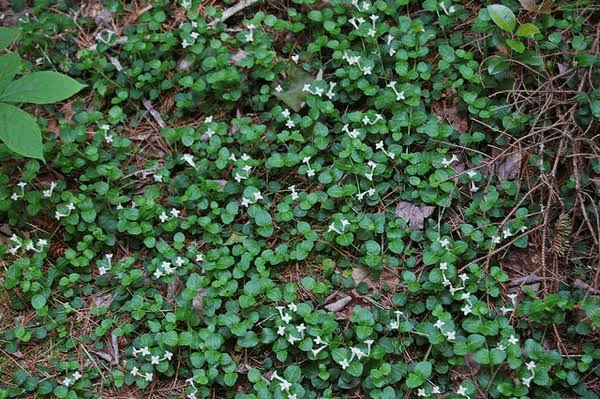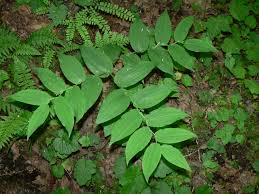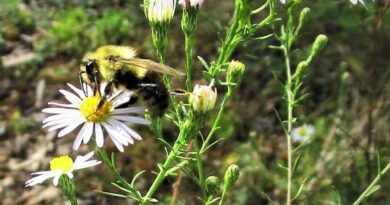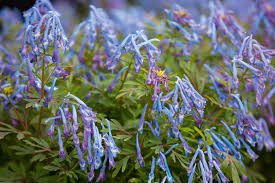5 Medicinal Health Benefits Of Mitchella repens (Partridgeberry)
Mitchella repens, commonly known as Partridgeberry, is a small, creeping plant that holds a special place in traditional medicine and folklore. In this article, we will discuss the botanical description of Mitchella repens, explore its historical uses, and uncover the potential medicinal benefits it offers.
The Botanical Description of Mitchella repens
1. Life: Mitchella repens is a low-growing, evergreen herb that belongs to the Rubiaceae family. It thrives in North America’s eastern regions, including parts of the United States and Canada.
2. Leaves: The leaves of Mitchella repens are opposite, glossy, and elliptical, measuring around 1 to 2 centimeters in length. They are dark green with a distinctive white midrib.
3. Flowers: Partridgeberry produces small, tubular, white to pale pink flowers. These flowers are typically paired, with two blossoms emerging from a single stem, which is one of the plant’s unique features.
4. Fruit: The plant’s fruit is a red, edible berry that resembles a partridge’s eye, hence its common name, Partridgeberry. These berries are about the size of a pea and can be found year-round in various stages of ripeness.
5. Growth Habit: Mitchella repens grows as a creeping vine, forming dense mats on the forest floor. It often thrives in shaded, moist woodlands and is a common sight in these environments.
6. Historical Uses: Native American tribes, such as the Iroquois and Ojibwa, have traditionally used Partridgeberry for its medicinal properties. It was employed to address a range of health concerns, including issues related to women’s reproductive health.
7. Folklore: Partridgeberry gets its name from the belief that it is a favorite food of partridges. Additionally, it has had symbolic importance in some Native American cultures, representing fertility and unity.
The Geographic Distribution of Mitchella repens
1. North America: Mitchella repens, commonly known as Partridgeberry, is native to North America. It is primarily found in the eastern regions of the continent, including the northeastern and southeastern United States, as well as parts of eastern Canada. This herbaceous plant thrives in the woodlands and forests of these areas, favoring shaded and moist environments.
2. Specific Regions: Partridgeberry can be spotted in various states in the eastern United States, such as New York, Pennsylvania, New Jersey, Virginia, and North Carolina. In Canada, it is found in provinces like Ontario and Quebec. Its distribution varies depending on factors like climate and habitat suitability.
The Chemical Composition of Mitchella repens
1. Flavonoids: Partridgeberry contains flavonoids, a group of phytochemicals known for their antioxidant properties. Flavonoids play a role in protecting cells from oxidative stress.
2. Tannins: Tannins are naturally occurring compounds found in Partridgeberry. They have astringent properties and are known for their potential role in wound healing.
3. Glycosides: Certain glycosides are present in Mitchella repens. These compounds can have diverse effects on the body and may contribute to its medicinal properties.
4. Organic Acids: The plant contains various organic acids, which can influence its taste and potential health benefits.
5. Vitamins and Minerals: While not a significant source of vitamins and minerals, Partridgeberry may contain small amounts of essential nutrients that can contribute to overall health.
The Harvesting and Processing of Mitchella repens
1. Harvesting: Partridgeberry is typically harvested in the wild. Harvesters collect the above-ground parts of the plant, including the leaves and berries. It’s important to practice sustainable harvesting methods to ensure the plant’s continued existence.
2. Drying: After harvesting, the plant material is often dried to reduce moisture content. Drying helps preserve the plant for extended use and prevents spoilage.
3. Processing: Partridgeberry is processed into various forms for medicinal use. This may include creating tinctures, teas, or herbal supplements. The dried leaves and berries are used in these preparations.
4. Traditional Uses: In traditional herbal medicine, Partridgeberry has been used for women’s health, particularly during pregnancy and childbirth. It has also been employed for its potential astringent and wound-healing properties.
Understanding the geographic distribution, chemical composition, and the process of harvesting and processing Mitchella repens provides valuable insights into its potential medicinal uses and historical significance.
Read Also: 10 Medicinal Health Benefits of Tabernaemontana pachysiphon (Smoothfruit Cornettree)
The Medicinal Health Benefits Of Mitchella repens (Partridgeberry)

Mitchella repens, commonly known as Partridgeberry, has been recognized for its potential medicinal health benefits:
1. Women’s Health: Partridgeberry has a historical association with women’s health. It has been traditionally used by indigenous tribes for its potential benefits during pregnancy and childbirth. It is believed to support uterine health and ease labor.
2. Astringent Properties: Partridgeberry contains tannins, which have astringent properties. This makes it useful in traditional herbal medicine for addressing various health concerns, such as wounds and gastrointestinal discomfort.
3. Antioxidant Effects: The flavonoids found in Partridgeberry are known for their antioxidant properties. These compounds help neutralize harmful free radicals and protect cells from oxidative damage.
4. Potential Anti-Inflammatory Properties: Some studies suggest that Partridgeberry may have anti-inflammatory effects, which can be valuable for conditions related to inflammation.
5. General Health Support: Partridgeberry is believed to provide overall health support, although scientific research on its specific health benefits is ongoing.
The Methods of Usage to Achieve the Provided Health Benefits Of Mitchella repens (Partridgeberry)
Various methods can be employed to harness the potential health benefits of Partridgeberry:
1. Herbal Preparations: Partridgeberry can be prepared as herbal teas, tinctures, or infusions. These preparations are used to address specific health concerns, including uterine health and gastrointestinal discomfort.
2. Topical Applications: For its astringent properties, Partridgeberry can be applied topically to wounds or skin irritations. It may help promote healing and reduce inflammation.
3. Traditional Remedies: In traditional herbal medicine, Partridgeberry has been used as a uterine tonic during pregnancy and childbirth. It is typically prepared as a tea or tincture and consumed under the guidance of a qualified herbalist or midwife.
4. Consult Healthcare Professionals: For specific health concerns or if you are pregnant, it’s essential to seek guidance from healthcare professionals or herbalists who can provide appropriate dosages and recommendations.
The Side Effects Of Using Mitchella repens Medicinal Plant
While Partridgeberry offers potential health benefits, it’s crucial to be aware of potential side effects and precautions:
1. Allergic Reactions: Some individuals may be sensitive or allergic to Partridgeberry. It’s important to perform an allergy test before using it, especially in concentrated forms.
2. Pregnancy and Lactation: While Partridgeberry has traditional uses during pregnancy, it should be used with caution. Consult with a healthcare provider or qualified midwife before use, especially during pregnancy and breastfeeding.
3. Digestive Discomfort: Ingesting Partridgeberry preparations in excessive amounts may lead to digestive discomfort, such as nausea or diarrhea. Follow recommended dosages.
4. Interaction with Medications: If you are taking medications, consult with a healthcare provider before using Partridgeberry products, as they may interact with certain drugs.
5. Monitoring Health: When using Partridgeberry for specific health concerns, it’s advisable to monitor your health and seek professional guidance for the best results.
Partridgeberry, with its rich history and potential health benefits, should be used with care and under the guidance of healthcare professionals, particularly during pregnancy and for specific health concerns. Always prioritize safety and seek professional advice when necessary.
Read Also: 10 Medicinal Health Benefits of Tabernaemontana pachysiphon (Smoothfruit Cornettree)
The Scientific Research and Studies of Mitchella repens (Partridgeberry)

1. Traditional Knowledge: Much of the knowledge about the medicinal uses of Partridgeberry comes from indigenous tribes, and this knowledge has been passed down through generations. While there is a rich history of traditional use, there is limited scientific research available on its specific health benefits. However, ongoing studies aim to explore its potential medicinal properties.
2. Women’s Health: Scientific investigations into Partridgeberry’s effects on women’s health, particularly during pregnancy and childbirth, are limited. Some studies have explored its uterine tonic properties, but more research is needed to understand the mechanisms and safety.
3. Antioxidant and Anti-Inflammatory Properties: Partridgeberry’s potential antioxidant and anti-inflammatory effects have drawn attention from researchers. These properties may contribute to its traditional uses for overall health support, but further scientific inquiry is necessary to validate these claims.
4. Chemical Analysis: Analytical studies have been conducted to identify the chemical constituents of Partridgeberry, including flavonoids and tannins. These compounds are of interest due to their potential health benefits.
The Safety Precautions and Recommendations In Using Mitchella repens (Partridgeberry) Medicinal Plant
1. Allergy Testing: Before using Partridgeberry products, especially if you are trying them for the first time, conduct an allergy test. Apply a small amount to a small area of skin and monitor for adverse reactions over 24-48 hours.
2. Pregnancy and Lactation: While Partridgeberry has traditional uses during pregnancy, it should be used with caution. Consult with a healthcare provider or qualified midwife before use, especially during pregnancy and breastfeeding.
3. Dosage Adherence: Follow recommended dosages provided with commercial products or by healthcare professionals. Avoid excessive consumption.
4. Interaction with Medications: If you are taking medications, particularly for specific health concerns, consult with a healthcare provider before using Partridgeberry products, as they may interact with certain drugs.
5. Monitoring Health: When using Partridgeberry for specific health concerns, it’s advisable to monitor your health and seek professional guidance for the best results.
FAQs About Mitchella repens (Partridgeberry) Medicinal Plant
Q1: Can Partridgeberry be used for fertility enhancement?
A1: Partridgeberry has historical use in some traditional practices for women’s health and fertility, but scientific evidence in this regard is limited. Consult with a healthcare provider for fertility concerns.
Q2: Are there any known adverse reactions to Partridgeberry?
A2: Allergic reactions are possible, although they are rare. Always conduct an allergy test when using Partridgeberry for the first time.
Q3: Can Partridgeberry be used as a natural remedy for wound healing?
A3: Partridgeberry’s astringent properties have led to its use in traditional medicine for wound healing. However, seek professional medical care for severe wounds.
Q4: Is Partridgeberry available in commercial herbal products or supplements?
A4: Partridgeberry is sometimes included in herbal preparations. Look for products from reputable sources and follow recommended dosages.
Q5: Can I grow Partridgeberry at home for personal use?
A5: Growing Partridgeberry at home can be challenging, as it has specific habitat requirements. It is more commonly harvested in the wild.
Q6: Can Partridgeberry be used to alleviate menstrual cramps or discomfort?
A6: Partridgeberry’s traditional uses suggest it may help with menstrual discomfort, but scientific evidence is limited. Consult with a healthcare provider for menstrual issues.
Q7: Is Partridgeberry safe for children, and are there any specific child-appropriate uses?
A7: Partridgeberry should be used with caution in children and under the guidance of a healthcare professional. Specific uses for children may vary.
Q8: Can Partridgeberry be taken alongside other herbal supplements or medications?
A8: Partridgeberry may interact with certain medications or other herbal supplements. Consult with a healthcare provider for guidance on combinations.
Q9: Are there any specific guidelines for sustainable harvesting of Partridgeberry in the wild?
A9: Sustainable harvesting practices are essential to ensure the plant’s continued existence. Harvest only a small portion of a population, leaving the majority undisturbed.
Q10: Is Partridgeberry considered an endangered or protected species in certain regions?
A10: Partridgeberry is not typically considered an endangered species, but regulations may vary by region. Check local guidelines on harvesting.
Q11: Can Partridgeberry be cultivated in home gardens, and are there specific care requirements?
A11: Growing Partridgeberry at home can be challenging due to its specific habitat requirements. Consult with experts in native plant gardening for advice.
Q12: Is Partridgeberry available as a dietary supplement in capsule or tablet form?
A12: Partridgeberry may be available in dietary supplements, but availability may vary. Look for products from reputable sources.
Q13: Can Partridgeberry be used for urinary tract health or infections?
A13: Partridgeberry has not been traditionally associated with urinary tract health. For urinary concerns, consult a healthcare provider.
Q14: Are there any known cases of toxicity or adverse effects associated with Partridgeberry when used as directed?
A14: When used as directed, Partridgeberry is generally safe. However, individual reactions are possible. Always follow recommended dosages.
Q15: Can Partridgeberry be used for skin conditions like rashes or insect bites?
A15: Partridgeberry’s astringent properties may provide relief for minor skin irritations. However, consult a healthcare provider for severe skin conditions.
Q16: Does Partridgeberry have any spiritual or cultural significance in indigenous communities?
A16: Partridgeberry has had cultural importance for some indigenous communities, symbolizing fertility and unity. Its use varies among tribes and cultures.
Q17: Can Partridgeberry be used for gastrointestinal issues, such as indigestion or bloating?
A17: Partridgeberry’s astringent properties may offer relief for minor gastrointestinal discomfort, but it’s not a primary treatment. Consult with a healthcare provider for digestive issues.
Q18: Can Partridgeberry be used for oral health, such as mouth ulcers or gum problems?
A18: Partridgeberry’s astringent properties may be employed for oral health, but it’s not a substitute for dental care. Consult with a dentist for oral concerns.
Q19: Are there any known interactions between Partridgeberry and specific medical conditions, such as diabetes or hypertension?
A19: Partridgeberry’s effects on medical conditions like diabetes and hypertension are not well-documented. Consult with a healthcare provider for guidance.
Q20: Can Partridgeberry be used to address anxiety or stress-related issues?
A20: Partridgeberry is not traditionally associated with anxiety or stress management. Seek advice from mental health professionals for such concerns.
Q21: Are there any specific recommendations for the storage of Partridgeberry products or preparations?
A21: Store Partridgeberry products in a cool, dry place, away from direct sunlight. Follow the storage instructions on product labels.
Q22: Is Partridgeberry recognized by any regulatory agencies for its health benefits?
A22: Partridgeberry is not widely recognized or regulated by health agencies. Its use is often based on traditional and cultural practices.
Read Also: Complete Radioactive Waste Management Guide









